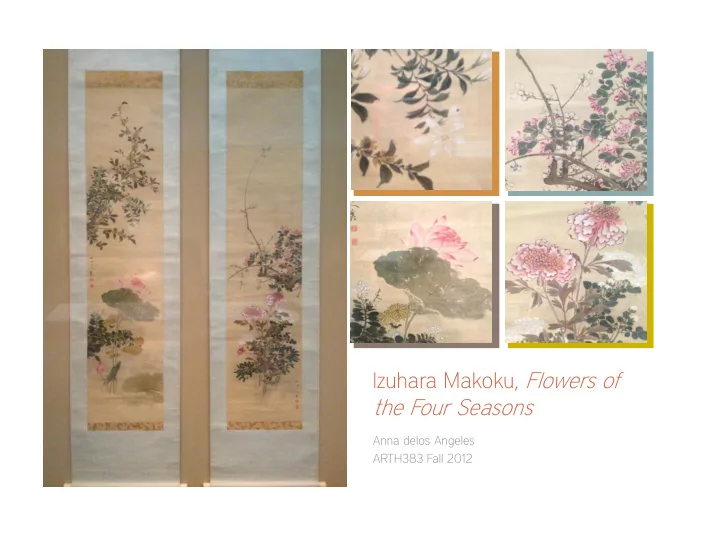

+ Izuhara Makoku, Flowers of the Four Seasons Anna delos Angeles ARTH383 Fall 2012
+ Izuhara Makoku, Flowers of the Four Seasons Pair of hanging scrolls Ink and color on silk Edo period, 1825-50
+ How might Makoku’s Buddist background have affected his painting style? What “range of cultural activities” did he engage in and how might that have affected his style? What was the nature of his relationships Research Questions with the other two of the “authoritative trio of Nagoya- born painters,” Yamamoto Baiitsu and Nakabayashi Chikuto? What do the flowers of the four seasons symbolize and how do they interact in these two scrolls? What effect does that achieve?
+ Buddhist monk from Nagoya, which possibly encouraged his “more reserved, less commercially directed life” Did not go on to become a prominent artist Izuhara Makoku No definite relation to Baiitsu and Chikuto “Range of cultural activities”?
+ Chikuto and Baiitsu Minor branch of Nanga painters in Nagoya Studied under the same mentor Seemingly different backgrounds from Makoku: Chikuto the son of a doctor associated with a wealthy businessman, and Baiitsu son of a carpenter Chikuto became the Nanga School’s main theorist Baiitsu pushed the boundaries a bit more
+ “Southern School” Japanese equivalent of Chinese literati painters of Yuan, Ming and Ching dynasties Well-versed in Confucianism, Chinese poetry, calligraphy, and painting The Nanga School Emphasis on individualism Background Rejection professional schools like Kano and Tosa painters Appealed to people of different classes
The Nanga School: Style “intuitive, individualistic … often deliberately amateurish and quasi- awkward … dependent for its expressive force on distinctive, sometimes calligraphic brushwork, repetitions and distortions of form, and other essentially abstract means” (Cahill 10) + “If birds and flowers are painted by one in whose brush resides the skill of awakening change, the painting will cause the viewer to cherish the moment depicted and, becoming involved with the picture, will take pleasure in the workings of nature.” – Chikuden Additive process: buildup of forms and texture; flattening of space (Moes 72, 77)
+ Somewhat awkward composition Calligraphic strokes Repetition and distortion Attention to detail; realism to an extent Layering of pigments and textures Scale Flattened picture frame
+ + Prunus : Winter Endurance, hope, transience First to bloom in late winter/early spring, also among first to lose its flowers Stylistic arrangement of flowers
Peony: Spring + + Wealth and honor Flower buds
Magnolia: Spring and Osmanthus: + + Summer Mixing motifs
+ + Lotus: Summer and Chrysanthemums: Autumn Mixing motifs Lotus: purity, integrity, success Chrysanthemum: escape from troubles, in praise of quietness
+ Izuhara Makoku, Flowers of the Four Seasons Pair of hanging scrolls Ink and color on silk Edo period, 1825-50
+ References Cahill, James. Scholar Painters of Japan: The Nanga School . New York: Asia Society, Inc., 1974. Graham, Patricia J. "Chinese Scholarly Imagery in Edo Period Paintings at the Indianapolis Museum of Art." Orientations (2001): 78-92. Moes, Robert. A Flower of Every Season: Japanese Paintings from the C.D. Carter Collection . Philadelphia: Falcon Press, 1975. Tanomura, Chikuden. "Sanch ū jin j ō zetsu." In Traditional Japanese Arts and Culture , edited by Stephen Addiss, Gerald Groemer, and J. Thomas Rimer, 167. Honolulu: University of Hawai'i Press, 2006. Originally published in Nanga Painting Treatises of Nineteenth Century Japan, (Lawrence: University of Kansas Press, 1991), 127-128. Welch, Patricia B. Chinese Art: A Guide to Motifs and Visual Imagery. North Clarendon: Tuttle Publishing, 2008.
Recommend
More recommend